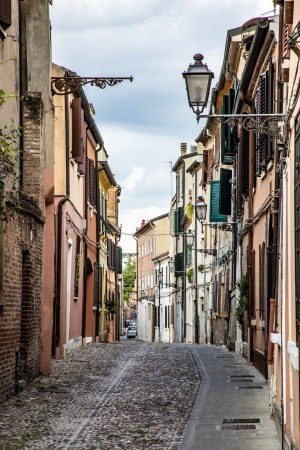Via Salinguerra
Road in the old town of Ferrara, which goes from Via Borgo di Sotto to Via Carlo Mayr.
Name and brief history
As noted by Gerolamo Melchiorri, this road was named after the famous, historical Ghibelline family: the Salinguerra Torellis. In Ferrara between the eleventh and thirteenth century, this Ghibelline line was engaged in challenges and quarrels against the Guelphs. As such, this period in Ferrara's history is marked by a sequence of bloody battles due to power clashes between the two factions, represented in Ferrara by the Salinguerras and the Adelardis, in addition to the House of Este. The Salinguerra family held on to power for a few decades, alternating with the Este family between the late twelfth and early thirteenth centuries through continuous struggles, placated by the supremacy of the Este family in 1264. The Este Signoria also began in that year, marked by the 7 February election of Obizzo II as lifelong ruler of Ferrara: it was his acclamation that put an end not only to the internal clashes within the city but also to the city's communal period. The name of the street is connected to the historic building owned by the Salinguerra family, destroyed by the Guelphs in August 1221, at the time of Marquis Azzo VII d’Este, also known as Novello. The building was re-constructed, only to be destroyed again: partially in 1676 and entirely in the nineteenth century. The structure was a veritable castle, with defensive walls, a moat and towers, as mentioned in the special plaque affixed by Ferrariae Decus at 191 Via Carlo Mayr. It was also once called Strada di San Salvatore, named after the tenth-century church of the same name which once stood at the corner of Via Borgo di Sotto. Its bell tower was originally a tower built by Tomaso Cavalieri, in front of which the larger tower of the Salinguerra family stood.
In literature
In his fictional version of Ferrara, the humble home of Lida Mantovani, the namesake protagonist of Giorgio Bassani’s story in Five Stories of Ferrara, part of The Novel of Ferrara, was found in this narrow street. The close proximity of three protagonists’ homes in three of the five stories is notable: close to Via Salinguerra are Via Campofranco, where Geo Josz lives in A Memorial Tablet in Via Mazzini, and Via Fondobanchetto, which is home to the antifascist teacher held on house arrest in The Final Years of Clelia Trotti.
Quotes
‘Rather irregular in shape, its cobblestones partly overgrown with grass, Via Salinguerra is a small, subsidiary street which begins in an ill-shapen square, the result of an ancient demolition, and ends at the foot of the city walls quite close to Porta San Giorgio. This places it within the city and not that far from the medieval centre: to confirm this impression, you only need to look at the appearance of the houses which flank both its sides, all of them very poor and of modest proportions, and some old and decrepit, undoubtedly among the oldest in Ferrara. And yet, strolling down Via Salinguerra, even today, the kind of silence that surrounds it (heard from here, the city’s church bells have a different timbre, as though muffled and lost) and especially the smell of manure, of ploughed earth, of cowsheds, which reveal the proximity of large hidden vegetable gardens, all contribute to the impression of already being outside the circle of the city walls, on the edge of the open countryside.’ (G. Bassani, ‘Lida Mantovani’, in The Novel of Ferrara, translated by Jamie McKendrick, Penguin Classics, 2018, e-book location 238) ‘It was called ‘Strada Salinguerra’ in memory of the famous Ghibellines, the Torelli Salinguerra family, which contested long and hard, with weapons and with its factions, the Este rule over Ferrara in the 12th century, and in the first half of the following...’ (G. Melchiorri, Nomenclatura ed Etimologia delle Piazze e delle Strade di Ferrara e Ampliamenti all’Opera di Gerolamo Melchiorri, edited by C. Bassi, 2G Editrice, Ferrara 2009, p. 131)
Bibliography
- Giorgio Bassani, Lida Mantovani in Opere, Il romanzo di Ferrara, Mondadori 2001
- Luciano Chiappini, Gli Estensi. Mille anni di storia, Corbo, Ferrara 2001
- Melchiorri, Gerolamo, Bassi, Carlo, Nomenclatura ed etimologia delle piazze e strade di Ferrara. Ampliamenti all'opera di Gerolamo Melchiorri, 2G, Ferrara 2009
Sitography
Compiling entity
- Assessorato alla Cultura e al Turismo, Comune di Ferrara
Author
- Barbara Pizzo

